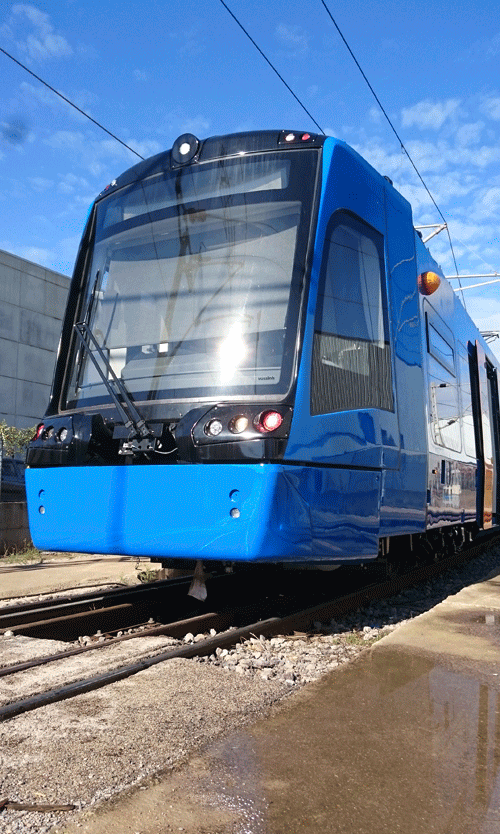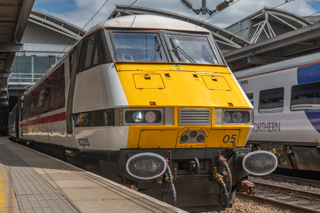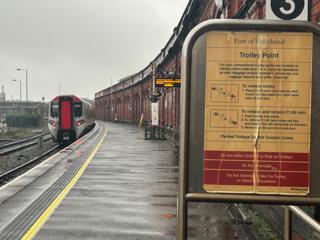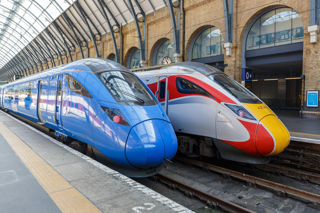Read part two of the Sheffield tram-train feature.
The answer comes so confidently, without hesitation, that it absolutely blindsides me. I might even have gasped, impolitely.
By this point, I’ve had two hours of being allowed to prod and poke around every aspect of Vossloh’s Citylink tram-train vehicle, and I’m as giddy as a ten-year-old on shed bunk.
The team have eagerly shared their insight into the design and development process. There are technical innovations galore awaiting the UK when the first of seven three-car vehicles finally reaches our shores - from the bogies to the running gear to, well, the whole thing, frankly.
So, “which aspect of the job are they most satisfied with?” No question. “The comfort of the seats.”
Are you sitting comfortably? Then we’ll begin. The Vossloh plant sits in several acres just north of Valencia, a stone’s throw from the Mediterranean frothing angrily at the sea wall. Like many companies, Vossloh can trace its roots back to the days when railways were first extending metals across their country. Recent expansion dictated moving to the current site in 1997, but history is not forgotten - a sizeable 2-8-2 steam locomotive is mounted opposite the main gate.
The greeting from the project team is warm - their hospitality is the first sign of the enthusiasm for the work that is under way here. And these are busy times, with new sheds being built on site.
The company is currently working on a dozen projects for various clients, three of them for the UK market. Having not so long ago worked on the Class 67 locomotives, Vossloh is now building the Class 68, the ‘88’ and the tram-train pilot vehicles. As we drive around to the test track, negotiating lines of new locomotives, some ‘68s’ are given away by their distinctive bulbous noses.
We arrive at a locked gate. “It will be here in a minute,” says one of the team. Sure enough, with a hoot any native of Sheffield might already find familiar, the UK’s first tram-train glides around a corner towards us, smoothly and silently.
First impressions count. In the sun it looks sleek and modern, already wearing the Stagecoach Supertram livery of deep blue, albeit without decals. (Later, as I have to lean on the bodywork to take pictures, it’s not without feeling guilty). Tantalisingly, the top panels have yet to be installed, revealing running gear that will be hidden once in service. It’s a natural place to start.
Between Network Rail, Stagecoach (which operates Supertram) and the South Yorkshire Passenger Transport Executive, the decision has been taken to opt for an entirely electric system, using a dual voltage - 750V DC in tram mode and the standard 25KV AC when running out onto the main line. As it crosses from the tram network to the heavy rail lines, the vehicle will pass through a ‘neutral zone’ where it will automatically switch modes.
Next to the pantograph is the equipment that will regulate the voltage sent down to the powered bogies. There are three of these (with another bogie being just a trailer), which is one more than on the vehicles Vossloh built for the tram-train network in the German town of Karlsruhe. The city of seven hills, Sheffield will require trams with a bit more oomph for the gradients!
The compressor is also up here, which provides air for the suspension. Placing the equipment up here gives the vehicle a door access height of just 425mm, which in turn means platform height is a mere 375mm.
Unlike the other early UK tram revival in Manchester, Supertram didn’t take over an existing urban commuter line. Instead, it mixes far more street running with newly built formation. The decision was taken at the time to provide low platforms throughout the network, which means station stops feel like extensions of the existing pavement.
The team are quick to point out that the new vehicle has self-levelling suspension. No matter the load, the vehicle platform will always be at this height - part of a commitment to barrier-free access for people who use wheelchairs, or who have children in buggies. This means innovative bogie design, too, again capitalising on the lessons from Karlsruhe.
It is apparently the low platforms that brought the tram-train pilot to South Yorkshire. This was the model that the authorities wanted to test.
The £240 million Supertram network currently covers some 18 miles, operating 25 German-built trams. The entire system (broadly speaking three lines, which converge in Sheffield city centre) was finally completed in October 1995. Tram-train is its first extension, and will (for the first time) take it outside of Sheffield, to Rotherham. This itself represents an investment of more than £50m.
Tram-train vehicles will leave their traditional network close to Meadowhall and cross onto a heavy rail line currently used by occasional freight trains. A connecting spur needs to be constructed, and the heavy rail route electrified.
From there, the vehicles will be able to reach Rotherham Central, where a low extension to the platform will be built. The ultimate terminus is some two miles further on, at the Parkgate Retail Park, where another spur will give Tram-Train its own station off the main line.
Experience in Germany comes up often during the tour, and it soon becomes clear that this is the touchstone for the UK pilot, not a blueprint. Indeed, soon after my visit, one of the customers (the South Yorkshire Passenger Transport Executive) praises Vossloh for its flexibility. It hasn’t sold an off-the-shelf product to the UK, but developed a bespoke solution. Combining technology and satisfying the regulations of a country with no experience of Tram-Train means innovation has been an ever-present partner. Inside and outside crash protection has been factored with subtlety, yet certainty.
Jorge Vara is Development Manager for Vossloh’s ‘Citylink’ family of vehicles. He joined the company as a student and has been here for 17 years. As we talk, his passion is obvious.
“Tram-train is good. It’s a mix of two systems in one. It provides the best of both systems - short braking distance, higher speed, barrier-free , big windows, the comfort of a train. So you are blending two well-known, well-running systems into one - that’s the benefit. It has been a challenge, it has been tough, but it is always exciting. We’re not such a big company, and we’re working close to the customer, face-to-face, day-to-day. So it’s working, working, working.”
I’m curious about why the decision has been taken to opt for the dual-voltage system, rather than an electric/diesel hybrid, particularly as a substantial length of heavy rail will need to be electrified.
“There was discussion at the beginning about what modes of tram-train should be used. I think the decision was made for budgetary reasons. There are a lot of benefits for electric systems - you have the access to electrified main line. The diesel option is always ready. We have it, but with electrified lines that dual system provides full access to the whole network.”
Technology has moved on in the 21 years since Supertram first started operating. On the new vehicles, gone are the drivers’ wing mirrors, to be replaced by cameras (similar to the modern Nottingham trams). A bank of headlights on the front (for the different modes of operation) is supplemented by fog lights, for those dark, northern days. And side reflectors have been fitted, so should the vehicle stop on a street without lights, it can still be seen - another German lesson, following accidents, apparently.
This first vehicle is still a few weeks from completion. Wires still hang from the windows, and inside a team of technicians are hunched over laptops. Time to step inside, where the first thing that crosses my mind is relief to be out of the warm September Spanish sun and into air-conditioned comfort.
That’s immediately followed by how light and open the interior is. If you’re used to travelling on Supertram that won’t perhaps surprise you, but if your normal commute involves a Pacer (or similar) from Rotherham to Sheffield Midland, it sure as hell will. You can easily see the entire length of the vehicle, and the large windows contribute to the ‘goldfish bowl effect’ that helps to make trams attractive.
Straightaway, I can see more evidence of the attention to detail. Colour-coded floors and doors help accessibility issues, while the long lengths of floor without steps and plenty of space for wheelchairs is testament to how far considerate design guides modern public transport.
The tram-train can nominally carry 240 passengers, a mix of roughly half and half sitting and standing. One thing they might not spot as they board is the passenger counting system - sensors hidden above the double doors will allow an accurate count of how many people get on and off at each stop, valuable data which can help to plan future timetables.
Bright yellow grab poles run floor to ceiling, replete with matching ‘push to request stop’ buttons. Two large digital ‘next stop’ displays are much easier to read, compared with the current Supertram vehicle. The windows are double-glazed, and adjacent to seats are recessed, in effect giving an armrest.
And speaking of those seats, they are a very comfortable 450mm wide, with plenty of legroom. They feel comfortable, bearing in mind that a journey may be measured in minutes, not hours. Many ‘float’ off the floor, paired with their neighbour and bolted to the wall, which will make cleaning and litter picking much easier.
Two lighting strips and air ducts punctuate the aluminium ceiling. Above passengers’ heads, lockers will carry more control equipment out of site - again a decision that enables the weight to be distributed along the whole vehicle.
As an aside, the team have worked with a design parameter of four passengers per square metre when standing. Tram-trains built recently for Brazil worked to ten per square metre, although in the UK they factor each passenger as weighing 75kg compared with 60kg elsewhere. I’d make a comment about our Steel city pie, peas and ‘Hendos’ at this point, but I’m definitely living in that greenhouse so won’t be throwing any stones!
We’ve already established that the seats are Vara’s favourite part of the finish. He elaborates: “All the seating areas are an equal level of comfort.”
He’s equally proud of how that has been achieved: “The soft suspension on the bogie. To get this level of comfort you need to provide a very soft and well-developed suspension system on the bogies, and a lot of technical things below that.”
Later, we’re taken for a short ride along the 2.5km test track on site. It can handle three gauges and three different voltages. Already it has been used to put more than 200 miles under the wheels of this prototype. Vara needlessly apologises for the state of the track - I’ve felt nothing but a smooth ride, repaying his faith in the suspension.
The drive leads us naturally towards the cab, where again plenty of thought has been put in to finding the right ergonomic solution. Supertram drivers will doubtless recognise some of it, while other elements will be new. I’m invited to sit in the air-suspended driver’s chair, while the motorised blind is lowered as the sun intrudes again. On the left is the power and brake handle, while built into the right-hand armrest of the chair are buttons for the horns. On the floor are the pedals for the sanders and the deadman control.
In front of the driver’s position, the controls quickly multiply because of the vehicle’s hybrid nature. (The tram-trains will be known as Class 399s for identification on the heavy rail network).
Besides the mandatory Train Protection and Warning System controls and Network Rail radio, there is also the Supertram radio. A large touchscreen controls lights and heaters (among other things), as well as providing information about what mode the vehicle is in and the voltage system that is in use. Next to that are the speedo and the door controls. To the right, a second screen has selectable CCTV views from the passenger areas. There is also the switch to change between tram and train modes. As stated above, most of this will happen automatically, but the driver will still need to select the right mode for some ancillary functions.
As the visit draws to a close, Vara is confident that the UK will embrace the new technology: “People like trains in the UK. We have a lot of experience there with locomotives. We know the standards, the maintenance needs, the contractual situation. All this knowledge helps us to work for success. Tram-train is the solution to a lot of different situations - with a new track, or with an existing old one, you can avoid civil works, you can use existing platforms…”
After a few more weeks testing here in Spain, this vehicle will be loaded onto a freighter headed for Southampton, and should be in South Yorkshire in December.
Vara explains: “We need to finish the testing and commissioning here on our test track. We need to be sure about all the safety systems - braking, accelerating, hazard protection. Not all tests will be finished here. We need to finish the last stage on the customer’s track - radio signalling, local things.”
Passengers are unlikely to be riding on the prototype until spring next year. Even then it will only be as a complement to the existing Supertram fleet, providing extra service capacity.
But there is a twist in this tale. While the vehicles are almost knocking on our door, and the Sheffield depot has been prepared, the upgrade work to prepare the physical infrastructure has barely begun. It will be 2017, almost a full decade after initial proposals, before tram-trains begin to operate in earnest. The pilot phase will officially last for two years, and there’s a keen expectation for it to be a commercially viable service. That will, in turn, dictate what happens next.
With the sun high in the sky, it is time to depart for the UK. As we leave, another similar-looking grey vehicle comes into view. “That’s a full diesel tram-train being constructed for Mexico,” explains one of the members of the team.
It seems the rest of the world is already on board with the concept. Vossloh could be busy for some time to come.
Read part two of the Sheffield tram-train feature.
- This feature was published in RAIL 788 on November 25 2015
















Login to comment
Comments
No comments have been made yet.